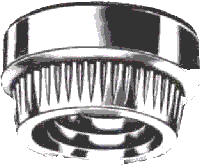 The Original
Plugnut® -- often imitated, never duplicated. |
Why They Are Used
PlugNuts® are hardened, threaded inserts designed to be
pressed into ductile materials to assure good fastening characteristics for
a part or product. First cost is low--installation is inexpensive.Once inserted, the PlugNut® becomes a "self-clinching" preplaced nut; ideal
for use in blind, hard to reach locations ad to improve fasten-ability for
thin or soft materials such as steel, brass and aluminum.
|
How They Work
Each PlugNut® is made with a tapered, knurled projection --the large end of
which is greater in diameter than the hole in which the nut will be used.
An annular groove separates the top of the projection from the underside of
the head of the nut. When the nut is pressed into a mating hole, the
wall material of the hole is radially displaced in an outward direction. Displaced hole material flows into the knurls and groove to clinch the nut
securely in place. This is accomplished without affecting flatness of
component product material.
|
 SHIRRING
& COMPANY
SHIRRING
& COMPANY